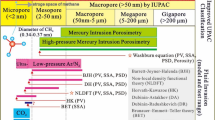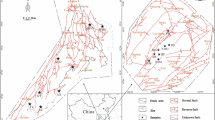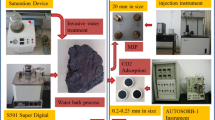Abstract
In China, the exploration and development of low-rank coalbed methane (CBM) resources are in the early stage, and in-situ pyrolysis is an effective technology for mining of low-rank CBM resources. In this paper, N2 adsorption method and high-pressure mercury injection test were used to study the pore structure characteristics of coal samples by water vapor injection, and the pore size boundaries of the two test methods were determined. From the continuous pore space distribution model, Frenkel–Halsey–Hill model, Menger sponge model, a new method of pore size classification is proposed: (I) (> 10,000 nm), (II) (1000–10,000 nm), (III) (100–1000 nm), (IV) (x (pore diameter boundary)–100 nm), (V) (10–x nm), (VI) (< 10 nm). The results were not inconsistent with the Hodot classification method, indicating that the new pore classification scheme is reliable. Meanwhile, the relationship between pyrolysis temperature and matrix compressibility is discussed, and it was found that transition pores had a significant effect on matrix compressibility. Pyrolysis weakened the connection between coal particles, improved the development of porosity, and led to high matrix compressibility. Furthermore, when pyrolysis temperature was < 400 °C and matrix compression effect was dominant, poor pore connectivity resulted in a low level of matrix compressibility; when pyrolysis temperature was > 500 °C and pore filling effect was dominant, high level of matrix compressibility was promoted.











Similar content being viewed by others
References
Ayers, W. B. (2002). Coalbed gas systems, resources, and production and a review of contrasting cases from the San Juan and Powder River basins. AAPG bulletin, 86(11), 1853–1890.
Barrett, E. P., Joyner, L. G., & Halenda, P. P. (1951). The determination of pore volume and area distributions in porous substances. I. Computations from nitrogen isotherms. Journal of the American Chemical society, 73(1), 373–380.
Brunauer, S., Emmett, P. H., & Teller, E. (1938). Adsorption of gases in multimolecular layers. Journal of the American chemical society, 60(2), 309–319.
Cai, Y., Li, Q., Liu, D., Zhou, Y., & Lv, D. (2018). Insights into matrix compressibility of coals by mercury intrusion porosimetry and N2 adsorption. International Journal of Coal Geology, 200, 199–212.
Cai, Y., Liu, D., Pan, Z., Yao, Y., Li, J., & Qiu, Y. (2013). Pore structure and its impact on CH4 adsorption capacity and flow capability of bituminous and subbituminous coals from Northeast China. Fuel, 103, 258–268.
Chalmers, G. R., & Bustin, R. M. (2007). On the effects of petrographic composition on coalbed methane sorption. International Journal of Coal Geology, 69(4), 288–304.
Chalmers, G. R., & Bustin, R. M. (2008). Lower cretaceous gas shales in northeastern British Columbia, part I: Geological controls on methane sorption capacity. Bulletin of Canadian petroleum geology, 56(1), 1–21.
Clarkson, C. R., & Qanbari, F. (2015). Transient flow analysis and partial water relative permeability curve derivation for low permeability undersaturated coalbed methane wells. International Journal of Coal Geology, 152, 110–124.
Deng, C., Tang, D., Liu, S., Xu, H., & Tao, S. (2015). Characterization of mineral composition and its influence on microstructure and sorption capacity of coal. Journal of Natural Gas Science and Engineering, 25, 46–57.
Flores, R. M., Rice, C. A., Stricker, G. D., Warden, A., & Ellis, M. S. (2008). Methanogenic pathways of coal-bed gas in the powder river basin, United States: The geologic factor. International Journal of Coal Geology, 76(1–2), 52–75.
Friesen, W. I., & Mikula, R. J. (1988). Mercury porosimetry of coals: Pore volume distribution and compressibility. Fuel, 67(11), 1516–1520.
Fu, H., Tang, D., Xu, T., Xu, H., Tao, S., Li, S., & Wang, L. (2017). Characteristics of pore structure and fractal dimension of low-rank coal: A case study of Lower Jurassic Xishanyao coal in the southern Junggar Basin, NW China. Fuel, 193, 254–264.
Gensterblum, Y., Busch, A., & Krooss, B. M. (2014). Molecular concept and experimental evidence of competitive adsorption of H2O, CO2 and CH4 on organic material. Fuel, 115, 581–588.
Gräbner, M. (2014). Industrial coal gasification technologies covering baseline and high-ash coal. John Wiley & Sons. https://doi.org/10.1002/9783527336913.index
Guo, X., Yao, Y., & Liu, D. (2014). Characteristics of coal matrix compressibility: An investigation by mercury intrusion porosimetry. Energy & Fuels, 28(6), 3673–3678.
Han, F., Busch, A., Krooss, B. M., Liu, Z., & Yang, J. (2013). CH4 and CO2 sorption isotherms and kinetics for different size fractions of two coals. Fuel, 108, 137–142.
Hodot, B. B. (1966). Outburst of coal and coalbed gas (Chinese Translation) (p. 318). China Coal Industry Press.
Homand-Etienne, F., & Houpert, R. (1989). Thermally induced microcracking in granites: Characterization and analysis. International Journal of Rock Mechanics and Mining Sciences & Geomechanics Abstracts, 26(2), 125–134.
Javadpour, F., Moravvej Farshi, M., & Amrein, M. (2012). Atomic-force microscopy: A new tool for gas-shale characterization. Journal of Canadian Petroleum Technology, 51(4), 236–243.
Kang, Z. Q., Zhao, Y. S., Meng, Q. R., Yang, D., & Xi, B. P. (2009). Micro-CT experimental research of oil shale thermal cracking laws. Chinese Journal of Geophysics, 52(3), 842–848.
Li, S., Tang, D., Xu, H., & Yang, Z. (2012). Advanced characterization of physical properties of coals with different coal structures by nuclear magnetic resonance and X-ray computed tomography. Computers & geosciences, 48, 220–227.
Li, Y. H., Lu, G. Q., & Rudolph, V. (1999). Compressibility and fractal dimension of fine coal particles in relation to pore structure characterisation using mercury porosimetry. Particle & Particle Systems Characterization: Measurement and Description of Particle Properties and Behavior in Powders and Other Disperse Systems, 16(1), 25–31.
Li, Y., Zhang, Y., Zhang, L., & Hou, J. (2019a). Characterization on pore structure of tectonic coals based on the method of mercury intrusion, carbon dioxide adsorption and nitrogen adsorption. Journal of China Coal Society, 44(4), 1188–1196.
Li, Z., Liu, D., Cai, Y., Wang, Y., & Teng, J. (2019b). Adsorption pore structure and its fractal characteristics of coals by N2 adsorption/desorption and FESEM image analyses. Fuel, 257, 116031.
Li, Z., Shen, X., Qi, Z., & Hu, R. (2018). Study on the pore structure and fractal characteristics of marine and continental shale based on mercury porosimetry, N2 adsorption and NMR methods. Journal of Natural Gas Science and Engineering, 53, 12–21.
Liu, A., Fu, X., Wang, K., An, H., & Wang, G. (2013). Investigation of coalbed methane potential in low-rank coal reservoirs-Free and soluble gas contents. Fuel, 112, 14–22.
Liu, S., & Harpalani, S. (2014). Compressibility of sorptive porous media: Part 1. Background and theory. AAPG Bulletin, 98(9), 1761–1772.
Mandelbrot, B. B., & Mandelbrot, B. B. (1982). The fractal geometry of nature (Vol. 1). WH freeman.
Nie, B., Liu, X., Yang, L., Meng, J., & Li, X. (2015). Pore structure characterization of different rank coals using gas adsorption and scanning electron microscopy. Fuel, 158, 908–917.
Pan, J., Wang, K., Hou, Q., Niu, Q., Wang, H., & Ji, Z. (2016). Micro-pores and fractures of coals analysed by field emission scanning electron microscopy and fractal theory. Fuel, 164, 277–285.
Pfeifer, P., Wu, Y. J., Cole, M. W., & Krim, J. (1989). Multilayer adsorption on a fractally rough surface. Physical Review Letters, 62(17), 1997–2000.
Meng, Q., Zhao, Y., Yu, Y., & Hu, Y. (2010). Micro-CT experimental study of crack evolution of lignite under different temperatures. Chinese Journal of Rock Mechanics and Engineering, 29(12), 2475–2483.
Ross, D. J. K., & Marc Bustin, R. (2009). The importance of shale composition and pore structure upon gas storage potential of shale gas reservoirs. Marine and Petroleum Geology, 26(6), 916–927.
Schobert, H., & Song, C. (2002). Chemicals and materials from coal in the 21st century. Fuel, 81(1), 15–32.
Scott, S., Anderson, B., Crosdale, P., Dingwall, J., & Leblang, G. (2007). Coal petrology and coal seam gas contents of the Walloon Subgroup-Surat Basin, Queensland. Australia International Journal of Coal Geology, 70(1–3), 209–222.
Sing, K. S. (1985). Reporting physisorption data for gas/solid systems with special reference to the determination of surface area and porosity (Recommendations 1984). Pure and applied chemistry, 57(4), 603–619.
Song, Y., Jiang, B., Shao, P., & Wu, J. (2018). Matrix compression and multifractal characterization for tectonically deformed coals by Hg porosimetry. Fuel, 211, 661–675.
Sun, Q. P., Zhao, Q., Jiang, X. C., Mu, F., Kang, L., & Wang, M. (2021). Prospects and strategies of CBM exploration and development in China under the new situation. Journal of China Coal Society, 46(1), 65–76.
Tao, S., Chen, S., Tang, D., Zhao, X., Xu, H., & Li, S. (2018a). Material composition, pore structure and adsorption capacity of low-rank coals around the first coalification jump: A case of eastern Junggar Basin, China. Fuel, 211, 804–815.
Tao, S., Zhao, X., Tang, D., Deng, C., Meng, Q., & Cui, Y. (2018b). A model for characterizing the continuous distribution of gas storing space in low-rank coals. Fuel, 233, 552–557.
Tiwari, P., Deo, M., Lin, C. L., & Miller, J. D. (2013). Characterization of oil shale pore structure before and after pyrolysis by using X-ray micro CT. Fuel, 107, 547–554.
Vernik, L., & Landis, C. (1996). Elastic anisotropy of source rocks: Implications for hydrocarbon generation and primary Migration1. AAPG bulletin, 80(4), 531–544.
Wang, B., Qin, Y., Shen, J., & Wang, G. (2017). Summarization of geological study on low rank coalbed methane in China. Coal Sci Technol, 45(1), 170–179.
Xu, H., Tang, D., Zhao, J., & Li, S. (2015). A precise measurement method for shale porosity with low-field nuclear magnetic resonance: A case study of the Carboniferous-Permian strata in the Linxing area, eastern Ordos Basin, China. Fuel, 143, 47–54.
Yang, D., Kang, Z. Q., Zhao, J., & Zhao, Y. S. (2011). CT Experiment research of oil shale under high temperature. Journal of Taiyuan University of Technology, 42(3), 255–257.
Yu, Y., Hu, Y., Liang, W., et al. (2012). The application of CT technology to study the pore change characteristics of lean coal at different temperatures. Journal of geophysics, 55(2), 637–644.
Zhang, J. (2016). Experimental study and modeling for CO2 diffusion in coals with different particle sizes: Based on gas absorption (imbibition) and pore structure. Energy & Fuels, 30(1), 531–543.
Zhang, S., Tang, S., Tang, D., Pan, Z., & Yang, F. (2010). The characteristics of coal reservoir pores and coal facies in Liulin district, Hedong coal field of China. International Journal of Coal Geology, 81(2), 117–127.
Zhang, S., Tang, S., Zhang, J., & Pan, Z. (2018). Pore structure characteristics of China sapropelic coal and their development influence factors. Journal of Natural Gas Science and Engineering, 53, 370–384.
Zhao, Y. S., Meng, Q. R., Kang, T. H., Zhang, N., & Xi, B. P. (2008). Micro-CT experimental technology and meso-investigation on thermal fracturing characteristics of granite. Chinese Journal of Rock Mechanics and Engineering, 27(1), 28–34.
Zhou, S., Liu, D., Cai, Y., Karpyn, Z., & Yao, Y. (2018). Comparative analysis of nanopore structure and its effect on methane adsorption capacity of Southern Junggar coalfield coals by gas adsorption and FIB-SEM tomography. Microporous and Mesoporous Materials, 272, 117–128.
Zhou, S., Liu, D., Cai, Y., & Yao, Y. (2016). Gas sorption and flow capabilities of lignite, subbituminous and high-volatile bituminous coals in the Southern Junggar Basin, NW China. Journal of Natural Gas Science and Engineering, 34, 6–21.
Acknowledgments
This work was supported by the National Natural Science Foundation of China (Grant nos. U1810104) and the Program for the Outstanding Innovative Teams of Higher Learning Institutions of Shanxi (183010148-S), and a research project supported by the Shanxi Scholarship Council of China (HGKY2019018).
Funding
National Natural Science Foundation of China, U1810104, Zijun Feng, Program for Professor of Special Appointment (Eastern Scholar) at Shanghai Institutions of Higher Learning,183010148-S, Zijun Feng, Shanxi Provincial Key Research and Development Project, HGKY2019018, Zijun Feng.
Author information
Authors and Affiliations
Corresponding author
Ethics declarations
Conflict of Interest
We declare that no conflict of interest exits in the submission of this manuscript, and manuscript is approved by all authors for publication.
Rights and permissions
About this article
Cite this article
Li, H., Feng, Z., Zhang, C. et al. Characterization of Coal Pore Structure and Matrix Compressibility by Water Vapor Injection. Nat Resour Res 31, 2869–2883 (2022). https://doi.org/10.1007/s11053-022-10109-9
Received:
Accepted:
Published:
Issue Date:
DOI: https://doi.org/10.1007/s11053-022-10109-9




